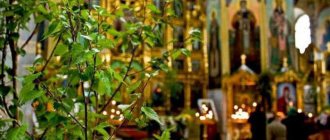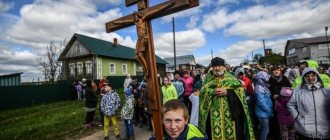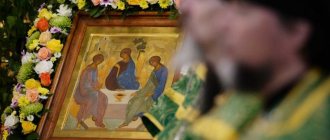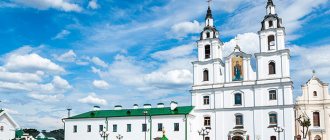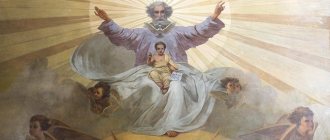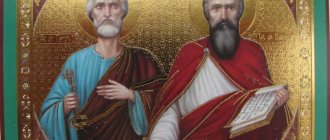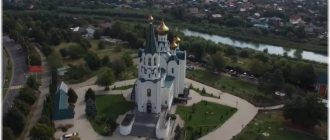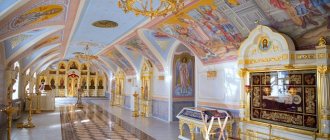The history of the Holy Trinity holiday
According to biblical covenants, it is believed that on this day the prophecy of Christ was to be fulfilled, and the Holy Spirit was to descend to earth. According to Scripture, this was supposed to happen on the tenth day after the soul of Christ ascended, and on the fiftieth after his resurrection.
On this day, in anticipation of a miracle, the Mother of God and the apostles gathered in the upper room at the usual time for prayer. Suddenly they heard a noise, and a holy fire appeared before their eyes, which burned but did not burn. Just at this moment the descent of the Holy Spirit occurred, which signified that they had undergone the baptism of fire and the Holy Spirit.
Over time, a crowd gathered outside the house. People came here from different countries to see the miracle with their own eyes. The apostles began to come out to them and talk to them in their native language. This could not but surprise, since everyone knew that the disciples of Christ were not scientists from Galilee and could not know the languages of other peoples.
The next miracle of this day is considered to be the sermon of the Apostle Peter, who had never preached before, but was only a humble disciple of his Teacher. But when he spoke, it became clear to everyone around him that the Holy Spirit Himself was speaking through his lips. The sermon was so heartfelt that many who listened to it believed in Christ and received Baptism on the same day.
The Day of the Descent of the Holy Spirit on the Apostles is considered the birthday of the Church. From now on, more and more people began to come to the prayer service of the apostles and listen to their sermons. And over time, the place of the Descent of the Holy Spirit on the apostles began to be considered sacred, where everyone can pray.
What you can and cannot do on Spiritual Day
What to do on the day of the descent of the Holy Spirit:
The fast that took place the week before is over, so there are no restrictions on food intake.
You need to go to church services and pray for all your family and friends.
Lighting a candle for the repose of the departed is another tradition among Orthodox Christians, which has been observed for centuries.
If you are preparing medicinal herbs, this day is ideal for collecting them. It is believed that plants acquire special healing powers, which are much greater than usual.
You can visit relatives or friends, or spend time with your family for pleasant communication.
On this church holiday you should not do the following:
Work on the garden plot, do repairs or anything else that can be put off. The holiday is a continuation of the Trinity, so it is not advisable to engage in any work. This does not apply to the performance of official duties; there are no restrictions in this regard.
Sewing, knitting and other similar work should not be done, although there is no direct prohibition.
For a long time, Orthodox Christians in Russia believed that you should never run on this day. A person can run away from his own destiny and thereby harm his future life.
It is important to welcome all guests on this day; hospitality cannot be denied to anyone. Otherwise, until the next holiday, according to the superstitions of our ancestors, there will be no money in the house.
It is also not customary to go to a cemetery; instead, it is better to light a candle in the church and pray for the deceased.
It is not advisable to wash dishes on this day, so if possible, postpone this task until the next day.
You should visit graves on Trinity Parents' Saturday, on the eve of the holiday.
How Baptism by Fire Changed the Apostles' Lives
After this day, the disciples of Christ changed very much. Until that day, they fell into despair and gave in to despondency, because they could not survive the death of their Teacher. Not everyone believed that the Son of God would resurrect and come to earth in a different guise, although He told them about this more than once. But the descent of the Holy Spirit on the apostles changed them dramatically. They became preachers of the Word of God who no longer betrayed their faith.
They believed, even though they knew about all the torments they would have to endure. As Christ prophesied to them, their lives would be given over to persecution, they would be ridiculed and slung with mud. Some were locked up in prison and mocked, just to “knock out” the faith from their souls and stop the endless chain of sermons. So that the burden of the apostles would not be so heavy, Christ sent His disciples the Comforter Spirit, who supported their faith and helped them endure all the hardships associated with persecution.
From now on, no one and nothing could make the apostles doubt their faith. Even during executions, beatings, and crucifixions, the spirit of Christ’s disciples became increasingly stronger.
The first Christians lived righteously, keeping all the commandments and following the teachings of the saints. They prayed every day, took communion constantly, and observed all the rules and customs. We tried to support each other everywhere and in everything, as Christ taught.
From the day of the Descent of the Holy Spirit upon the Apostles, Christian believers began to become more and more numerous throughout the world.
Initially, the apostles preached their sermons only in Palestine. And then they decided to go in different directions. The apostles cast lots to decide who should go in which direction. Andrew the First-Called was given the lot to go towards the Russian lands.
"Trinity" or "Pentecost"
The word “Pentecost” has a double name, which indicates its Old Testament origin. The concept of the “Holy Trinity” originates from the New Testament. But despite this, these two concepts are the names of the same holiday.
So, let's bring some clarity. Initially, Pentecost had nothing to do with the event of the Descent of the Holy Spirit on the Apostles. It was one of three holidays that related to the passing of legislation during the time of the prophet Moses. Then the Jews at the foot of Mount Sinai promised the Lord God to be faithful to Him, and He, in turn, to protect them from the persecution of the Egyptian Pharaoh. Pentecost also coincided with the harvest, which caused double joy in people. A large number of Jews who lived in various parts of the Roman Empire tried to come to Jerusalem on this day. Many of them have already forgotten their native language, but they have always respected the customs of the people. And at least once in his life, even in those days, every Jew sought to make a pilgrimage to his native places.
And after more than one and a half thousand years, the New Testament Pentecost acquired a new meaning. And on the day when the Holy Spirit descended on the fiftieth day, all the prophecies began to come true and the promises of the Son of the Lord to be fulfilled, that He would send the Comforter Spirit from His Father. And the Spirit of truth will testify to His Resurrection. Thus, Christ made it clear to his disciples that the Holy Trinity was with them until the end of their days.
Thus, the Pentecost of the Descent of the Holy Spirit on the Apostles began to be called the Holy Trinity.
Icon of the Descent of the Holy Spirit on the Apostles: description
The description of the plot on the icon is based on a story from the writings of the apostles.
It is from this description that the story of the apostles and the Mother of God, who were consecrated by fire, has come down to our times. But, despite the fact that the story is the same, the iconography of the Descent of the Holy Spirit on the Apostles has several options. This is due to the fact that each generation had its own traditions of painting icons. Over time, the images changed somewhat. It was only in the 8th century that the rules for painting icons were discussed and recorded.
Therefore, several variations of the image of the Descent of the Holy Spirit on the Apostles have come down to our time, which are divided into two directions. Historical version of writing - the icon painter tries to convey on canvas as truthfully as possible the events that took place at that time. The liturgical version implies revealing the meaning of the event that happened that evening. Both options have a right to exist, but are somewhat different from each other.
Signs for Spiritual Day
This day has been endowed with special properties since the times of Ancient Rus', so there are many signs associated with it that many still remember. Some of them changed along with ideas about the world around them, others remained almost in their original form. The ancestors believed that only after Spiritual Day one could be sure that there would be no night frosts; before that, warmth was considered deceptive.
As for signs, the most famous of them are:
- Whatever the weather will be on the day of the holiday, this will remain the case for the next six weeks.
- After Spiritual Day, prolonged heat should set in, regardless of the ambient temperature.
- If it rains, whether all day or occasionally, the coming summer and fall will be sunny and warm. Signs of the weather are considered the most significant; they are the ones that are most often given the main attention.
- It is advisable to go to a church service and bring at least one birch twig from there. Grace and happiness will enter the house with her.
- You definitely need to wash your face in the morning. The best thing is dew, but in cities this is not always possible. In rural areas you can use well water, and in cities you can use tap water. But it is advisable to pour it in advance and let it sit for at least a couple of days.
- Anyone who helps someone in need with a pure heart will have good luck all year long. Help can be either material or any other – even volunteer work.
- You cannot sweep the floor on this holiday - you can sweep away joy and good luck from the house along with the rubbish.
Different regions have their own signs, which may differ from those listed. This is due to the fact that many of them originated from pagan rituals, the roots of which go back to pre-Christian times.
A common variant of writing an icon
Most often you can find the icon of the Descent of the Holy Spirit on the Apostles in the center with the sitting Apostle Paul - a liturgical version of the spelling. It depicts the apostles sitting in a semicircle with books and scrolls in their hands and having a lively conversation. Light emanates from above them, and darkness is depicted below. Darkness symbolizes peace, until the condescension of the holy fire. People of different nationalities are also placed here, waiting for the light of the Gospel.
And what is typical in this spelling is that the apostles Peter and Paul sit in the center. Although the Apostle Paul was not at the convergence then. But the authors of many books cannot forget about him, since he is considered the supreme apostle. Therefore, iconographers place it on the icon of the Descent of the Holy Spirit on the Apostles. The photo (liturgical version) is located below, where the apostles are written with halos above their heads and tongues of flame at their mouths. This is a symbol of the fact that they were enlightened by the Holy Spirit.
In this version, under the dome of one of the churches of the Descent of the Holy Spirit on the Apostles, twelve disciples of Christ are depicted in a circle. The king appears in the middle. He has twelve scrolls in his hands. Above the head of this figure, instead of a halo, there is the inscription “Cosmos”. The figure in the form of a king represents a universe filled with different peoples. The apostles will have to go around the world and enlighten them all.
Japanese icon "The Descent of the Holy Spirit on the Apostles"
The icon of the Trinity or Pentecost has a complex iconography. Comforter , to the apostles was fulfilled .
He will teach them everything and remind them of everything. This event is celebrated as the birthday of the catholic, universal church. The holiday of Trinity is associated with the remembrance of ancestors, greenery, the longest and most beautiful service of the year.
After Trinity, the next day, the Day of the Holy Spirit is celebrated. But it so happens that it is less revered than Sunday Trinity, although Pentecost is the day of the Holy Spirit.
Catholics have a clear division in this sense: the two holidays are separated by calendar and are celebrated separately. One resurrection is Pentecost, like ours, the second is Trinity.
The holiday thus has two icons. One is the Trinity, the theological idea of which is most transparently expressed in the icon of Andrei Rublev, the other is Pentecost or the Descent of the Holy Spirit on the Apostles.
Icon "The Descent of the Holy Spirit on the Apostles"
This icon is located in the festive row of the iconostasis, while the Trinity icon is at the very top, crowning the iconostasis. Those. they are even distributed in different places in the iconostasis. We will tell you about two wonderful icons, first about the icon of Pentecost, then about the Trinity.
The icon of Pentecost has a very interesting history, since its iconography was not easy to develop, and the final scheme of the holiday was never established. On some icons the Mother of God is depicted, on others there is empty space, on some icons the Holy Spirit is depicted in the form of a dove, on others - in the form of flames, on others the symbols of the Holy Spirit are combined into a single image.
Greek icon "The Descent of the Holy Spirit on the Apostles"
The fact is that at the beginning of the Christian era, the holidays of the Ascension and Pentecost were not separated in time, as they are now, just as the holidays of the Nativity of Christ and the Epiphany were not separated.
Therefore, in the first images, the two events - the Ascension and Pentecost - were one: Jesus Christ Ascends to heaven and from there the hand of God sends tongues of flame towards the apostles. When there was a need to separate two images, because... holidays began to be celebrated separately, the simplest way was found - to take the same scheme as a basis - the Mother of God in the center of a group of apostles standing, and tongues of fire descending on them from above.
But theologically this was inaccurate, because the Ascension ends the period of Christ’s economy, and Pentecost opens a new stage - the creation of the church and the beginning of the economy of the Holy Spirit.
A solution was found. The holiday of Pentecost was based on the ancient image of group portraits of philosophers and sages sitting in a semicircle. First, this scheme became widespread in the image of the Feast of the Midsummer, where Jesus sits in the center of the apostles, then the same scheme was taken for the icon of the Feast of the Council of the Holy Fathers, which was celebrated last year - the seventh Sunday after Easter, and then for the Feast of Pentecost.
Icon "Pre-pubescence". or "Jesus Christ among the disciples"
On the icon, which is considered canonical, we see the apostles sitting on an arched bench, six people on the left and right. In the center, between the apostles Peter (left) and Paul (right), a place is left for the Ascended, but remaining head of the Church, Jesus Christ. This icon is sometimes even called the second Last Supper.
Below, two semi-arcs form an arch in which the ancient image of the Cosmos is visible, which is typical for many icons, for example the icon of Baptism, where Jordan is depicted as a gray-haired old man, and the sea as a running woman.
The cosmos stands against a dark background with a sacred plate on which 12 scrolls lie. They symbolize the sermons of the apostles, who, after receiving the Holy Spirit, according to the word of the Lord, were to go to teach all nations sitting in darkness and the shadow of death. Darkness is personified by the background against which we see Space.
Canonical Russian icon “The Descent of the Holy Spirit on the Apostles”
Rays of light with fiery tongues of flame descend on the apostles from above. On the icon, all the apostles have a halo, in contrast to the icon of the Ascension, on which only the Mother of God, who was the first to receive the Holy Spirit, had a halo.
The disagreement in icons concerns two questions: should the Virgin Mary be depicted in the center? And the second is the prohibition of the Stoglavy Council of the 16th century to depict the Holy Spirit as a dove: in the book of Acts the Holy Spirit was in the form of tongues of fire, not a dove. He appeared in the form of a dove only at Baptism.
In Rus', until the 17th century, it was customary not to depict the Mother of God among the apostles, but gradually, as we became secularized and increasingly looked to the West, Catholic images of Pentecost were taken as a basis, in which the Mother of God was always depicted, starting from the 10th century. Given the cult of the Virgin Mary, this was natural for the West.
El Greco. The Descent of the Holy Spirit on the Apostles
But for Russia this was alien, especially since in the Acts of the Apostles, which tells about this event, there is no direct mention of the Mother of God. However, there is no mention of the Apostle Paul, who is also depicted here. He could not be among the apostles, because he had not yet been converted from Saul to Paul and was in the camp of the persecutors of Christians.
Here Tradition, and not Holy Scripture, comes into force. According to Tradition, the Mother of God was present at the moment of the descent of the Holy Spirit along with the apostles, but if the Mother of God had already received the Holy Spirit earlier, then it seems that there is no need to receive It a second time.
In other words, there are several images of Pentecost, which in Orthodoxy are accepted with equal canonicity: without the Virgin Mary and with the Virgin Mary, with or without a dove.
Coptic icon "The Descent of the Holy Spirit on the Apostles"
But I like not only Russian icons, but also those that bear very clear traces of the ethnographic features of the perception of the holiday.
At the very beginning of the text there is a Japanese icon of Pentecost, very laconic, without unnecessary details, but recognizable at first sight. I really like it because it is somewhat similar to Malevich’s paintings.
A little higher in the text is a Coptic icon - also understandable, but with its own peculiarity: here we see in the center the Mother of God, who took the place of Jesus.
Chinese icon "The Descent of the Holy Spirit on the Apostles"
But here is a Chinese icon with its own national specifics and also with the Mother of God in the center. And all the icons are very interesting, all unusual, with their own theological meaning and their own figurative picture. There are Ethiopian, Armenian, and Greek icons.
In Russia, loyalty is largely maintained to the early tradition of painting the Trinity icon, which very accurately and transparently reflects the essence of Pentecost.
Tina Guy
Interesting? Share information!
Historical version of the icon spelling
In the historical depiction of the icon, despite the fact that, according to the tradition of the Holy Evangelist Luke, who described the Descent of the Spirit, the event took place without the presence of the Mother of Jesus Mary, her face is central. In the icon, all the apostles are sitting in a semicircle, but without a halo, unlike the liturgical image, and the blessed fire emanates from above on them. The halo is only above the head of the Virgin Mary, which indicates that she was the first to receive the grace of the Holy Spirit.
This image is very reminiscent of the icon of the Ascension. It is also called Little Pentecost. Also, the icon often depicts the Holy Spirit in the form of a dove, but such an image is considered not canonical. As we know, of the entire Holy Trinity, only the Son of God has an image. As for the Holy Father and His Spirit, from time immemorial they have not had a hypostatic incarnation.
It was at the Council of the Stoglavy, which took place in the mid-16th century in Moscow, that the question was raised that the Holy Spirit should not be depicted in the form of a dove, except during the celebration of Epiphany. According to the Gospel Scripture, only on the day of Epiphany the Holy Spirit appeared to the people in the form of a dove. And on the Pentecost icon it was decided to depict the Holy Spirit in the form of a fiery flame, as he appeared to the apostles that evening.
We should also not forget about the “Holy Trinity” icon, which is often identified with the “Pentecost” icon. Although these are completely different images. The icon of Andrei Rublev was declared canonical at the Stoglavy Assembly. It depicts three angels who personify the Persons of the Holy Trinity.
Prayer for the Descent of the Holy Spirit
O Heavenly King, Holy Comforter, Soul of Truth, who is everywhere and fulfills everything, who never begins, who ceases below, but who is ever present with the Father and the Son, who first acted in the Angelic Armies, bestowing sacredness;
and at the beginning of the world, rushing on top of the waters, like the Giver of life, I inspired the first-born people into paradise with the breath of life and the sweet communication of the Divine, but after the fall of our ancestors, I did not want to remain with the fallen sons of men, having become flesh, but rather in the elect of the patriarchs and the prophet of old who spoke with his father,
in the last days, desiring to pour out His Spirit on all flesh, first on the Most Honest of the Powers of the Most Holy Virgin Mary, He descended and accomplished the great sacrament of the Incarnation of the Son of God inexpressibly, and again on the same Son of God,
who came in the flesh to the Jordan, resting in the form of a dove, and therefore on the great day of Pentecost, essentially in the vision of a fiery tongue descended upon the Apostles and with these enlightened the entire universe and the Holy Church until the end of the age, abundantly fulfilling with His Divine grace, to deify and deify our fallen nature. return to heavenly bliss!
Look then, on this great, perfect and final Pentecostal feast, to the prayers of Your servants kneeling before You, and cleanse us with Your sacred influx from the many sins we have committed throughout our lives. The One Pure and Most Holy Soul,
Cleanse us from our many uncleanness, and do not forsake us even if we live according to the flesh, since Your Spirit does not dwell in the flesh of men, because flesh and blood cannot inherit the Kingdom of God. For this reason we pray to Thee:
With Your life-giving breath, extinguish all the flames of our passions, so that we may not create carnality in lusts, but guided by You, may we glorify You in our souls and bodies.
And deliver us from the spirit of idleness, despondency, sadness and pride and grant us the spirit of meekness and purity, the spirit of humility and chastity, the spirit of patience and love, so that you may come to the inner temple of our souls and reign there over our passions,
so that we sow no longer to flesh and corruption, but to spirit, so that from Your Spirit we will reap eternal life at the last Resurrection and glorify You from the faces of the saints with the Father and the Son forever and ever. Amen.
By leaving a comment, you accept the user agreement
Painting "The Descent of the Holy Spirit on the Apostles." Vrubel
The famous plot performed by the artist Mikhail Vrubel became part of the fresco in the St. Cyril Church in Kyiv. The painting depicts the twelve apostles who came after the resurrection of Christ with His Mother and prayed. The Mother of God is depicted in the center. A sacred fire emanates above her head, in the center of which a dove flies. Its rays diverge over the heads of each apostle. The participants in the picture do not have scrolls in their hands, but there is a halo above the heads of each of them.
Traditions and signs for Pentecost
It is customary to celebrate Trinity, the Descent of the Holy Spirit on the Apostles, for three days. On the eve of the holiday, all housewives put their homes in order. They remove and place branches of willow, birch or linden around the house. This is a symbol of the beginning of a new blooming life.
The day before the holiday is considered a memorial day. They bring gifts to church to remember their deceased relatives.
For the celebration, housewives bake pies and prepare many delicious dishes.
The first day of the holiday is called Green Sunday. It is believed that on this day all the evil spirits will come out and take away innocent souls, and the greenery placed around the house is protection from all sorts of mythical characters. In the morning people go to church for worship. Afterwards they go to visit each other. Often mass celebrations are organized in the form of fairs.
Today, for some reason, Trinity is considered a holiday for unmarried girls who weave wreaths on this very day and send them sailing along the river. And they watch where the wreath floats, and the groom will appear to her on the other side. A loaf of bread is also baked and distributed to the girls. They dry pieces of the loaf, and then during the wedding, its crackers are mixed into the dough of the loaf. It is believed that such magical baked goods will bring prosperity and prosperity to the house. The party continues until the evening with a picnic and mummers.
Klechal Monday is the second day of the celebration, when priests after the service go to the fields and read prayers there for a good harvest.
The third is God's Day. The guys choose their own bride. Also on this day, water in wells is blessed in villages.
It is believed that if it rains on Trinity Sunday, it means the harvest will be good and the summer will be warm. According to tradition, every morning girls wash themselves with dew that will fall on one of three days in order to preserve their beauty and youth as long as possible.
The celebration also has its own prohibitions. On these days it is prohibited to work on the land. But at the same time, you can collect medicinal herbs. Swimming in the river is considered dangerous. According to ancient belief, mermaids come out of the water and live in fields and forests. And they are dangerous because they can tickle the traveler they meet to death.
Church traditions
The Church always celebrates the Day of the Holy Spirit in a certain order, which has evolved over hundreds or even thousands of years. The roots of all the described traditions go deep into antiquity, some have changed over time, but the main part has remained virtually unchanged.
It should be noted that the first festive service begins the evening before. The clergy always read the prayer “To the King of Heaven . Kneeling three times by parishioners and priests is obligatory. During the process, they ask for the repose of the souls of the dead, and it is also customary to sing canons. And the next day they always hold a long morning service.
It is believed that Trinity and Spiritual Day symbolize eternal life, so it has long been customary for clergy to dress in green clothes. Churches are decorated with birch branches; this tradition dates back to Old Testament times. It is believed that from the first years of Christianity, people brought the first greens as gifts. And the room in which the apostles prayed when the Holy Spirit descended to them was decorated with green branches.
During the New Testament, the tradition acquired new meaning and began to symbolize the birth of new life thanks to the descent of the Holy Spirit. Every year nature is renewed and thus the cycle of life continues again and again. It is important to understand that this holiday is an integral continuation of the Trinity, dedicated to one of the hypostases of God, which is not given as much attention as others.
It is customary to light candles for the repose of those who are no longer with us, remember them with kind words and read prayers for the repose of the soul. And after the service, many set the table and invite loved ones to socialize in a close circle.
Features of the celebration of Pentecost in churches
In churches, the Descent of the Holy Spirit on the Apostles is celebrated with special respect. This is one of the main Christian holidays of the year, which is equal in importance to Easter and the Nativity of Christ. On the first night from Saturday to Sunday there is a night service. On the first day of the holiday, the usual chants are canceled. Instead, special holiday songs can be heard in churches on this day.
The whole service is not going as usual. After the liturgy, the evening service begins, during which the condescension of grace is celebrated with three special prayers. The priests themselves wear beautiful emerald robes for this holiday. The church, just like houses, is decorated with various green branches and flowers.
It is also worth remembering that after the holiday you don’t have to fast for a whole week.
FAQ
When should you not touch the ground?
The ban applies to all significant church holidays. This is due to the fact that if the peace of the earth is disturbed, troubles and misfortunes will await a person. This applies not only to the harvest, but also to other areas of life. Just make it a rule to complete all urgent tasks the day before so as not to violate the prohibitions.
Why can’t you touch the earth on Spiritual Day?
An old saying says that on Spiritual Day the earth is the birthday girl. Therefore, it is prohibited to carry out any work on this holiday. This is a kind of birthday of the earth, when sowing work is completed and all that remains is to wait for the new harvest. Therefore, it is important to give the earth a little peace, so that later it will reward you with a good harvest.
Is Spiritual Day a church holiday or not?
This is, without a doubt, a church holiday, which is always celebrated the day after Trinity. But at the same time, some folk traditions are also associated with it, dating back to the times of paganism. The church has a number of rules regarding this holiday. It comes earlier, because the evening service is always held the day before. There is no separate icon, since the Holy Spirit is not depicted in any way; the same attributes are used as on Pentecost.
What prayers should you read on Spiritual Day?
Most often on this day the prayer “To the Heavenly King” is read; it is traditional for Spiritual Day. There are others addressed to the Holy Spirit. But, as the clergy note, on the holiday the very fact of prayer is important, you can read what you know, the main thing is to turn to the Lord on this day.
